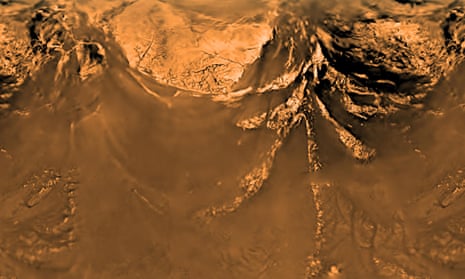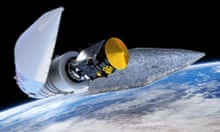Without water, life as we understand it would be impossible. It is the one substance upon which our existence depends. And now it has been found streaking down the red, dusty slopes of the hills of Mars.
The discovery, announced by Nasa last week , that the Red Planet has running water has provided scientists who are seeking life there with a major boost. As Jim Green, Nasa’s director of planetary science, put it: “If you look at Earth, water is an essential ingredient. Wherever we find water, we find life.”
Hence the international acclaim for the discovery, although the hunt for water, and life, in the solar system is not restricted to Mars. Indeed, astronomers have recently found that our solar system is awash with tantalising pools of the stuff, including several moons of both Jupiter and Saturn. Now researchers are competing for funds to back projects to study these very different, remarkable worlds, even though some are found more than a billion miles from the nurturing warmth of the sun.
It is a tour of the solar system that takes us deep into space, though it begins at Mars, one of our nearest planetary neighbours. Space engineers have been sending probes there for decades, but until recently their record was poor, with a substantial number either missing or crashing into their targets. Success rates have improved over the past decade, however. As a result, there are now five satellites in orbit round Mars, all returning data, while two robot rovers continue to trundle across its surface.
Nevertheless, it has taken this armada a very long time to find evidence of water on the planet, which shows how inhospitable and arid conditions are on Mars. Its atmospheric pressure is only 0.6% of Earth’s and its surface is bombarded by ultraviolet radiation. Any reservoirs of water or deposits of lifeforms will exist only underground, scientists believe. Finding them will be tricky.
One bold effort will be made by Europe’s ExoMars lander mission in 2018. Launched on a Russian Proton rocket, it is designed to set down a robot rover that is under construction at Astrium’s construction plant in Stevenage, Hertfordshire. The rover will be fitted with a long drill that will allow samples to be taken from depths of two metres. These will then be analysed for signs of biological activity.
“ExoMars is designed to identify complex organic materials, but in a way that will allow scientists on Earth to determine if they were produced by living organisms or by straightforward chemical activity,” said Ralph Cordley, a project leader for the ExoMars mission. “The fact that we now have found signs of running water on the Martian surface is tremendously encouraging, of course.”
Water on Mars remains a tantalising prospect, nevertheless – in contrast to several other parts of the solar system where it exists in abundance. Of these, Europa – one of the main moons of Jupiter – is probably the most striking. Covered in a coat of ice, it is the smoothest object in the solar system (with the possible exception of George Clooney) and is known to have a reservoir of water, mixed with organic materials, deep below its surface.
This alien ocean is also considered to be a likely place to find life and two separate missions – to be launched around 2020 – are now being designed to study Europa: the US Europa mission and the European Juice – Jupiter Icy Moon Explorer – mission. The latter will also investigate Jupiter’s moons Ganymede and Callisto. By contrast the US mission will concentrate on Europa, making dozens of sweeps over its surface in an attempt to detect any complex, organic material that might evaporate from its surface.
“If there is life in Europa, it almost certainly was completely independent from the origin of life on Earth,” said Robert Pappalardo, the mission project scientist. “Europa is so important because we want to understand: are we alone in the universe?”
Not everyone agrees with this idea of Europa’s prime importance, however. John Zarnecki, a director at the International Space Science Institute in Berne, Switzerland, believes an even more distant target provides richer promise of finding watery life in the solar system: Titan. Orbiting the planet Saturn one billion kilometres from Earth, the moon, which has a thick atmosphere of nitrogen, has been revealed to be a world with lakes and seas of methane on its surface.
“It also has great stretches of dunes and complex hydrocarbons,” said Zarnecki, who helped design key instruments for the Huygens probe that landed on Titan in 2005. “Most exciting of all, however, are the signs – provided by radar studies of Titan – that it also has a subsurface ocean and that could provide a home for primitive life,” said Zarnecki. “Titan probably has a warm core which is keeping that layer of water in a warm liquid state. Thus, we have the prospect of a rich soup of hydrocarbons, created on the surface, and which could be filtering through Titan’s crust to a subterranean ocean. Perfect for life. There could be colonies of bugs thriving down there.”
Titan is remote, and drilling down through its surface to an underground ocean will be extraordinarily difficult. One idea is to land a spaceship on one of Titan’s lakes of methane, where it could sail around searching for complex organic chemicals, the precursors of life. However, the mission – the Titan Mare Explorer (TiME) – was recently vetoed by senior Nasa officials, although Zarnecki and others hope it will be resurrected.
Titan is not the only moon of Saturn to attract attention, however. Observations by the robot craft Cassini, which has been orbiting Saturn since 2004, have shown that, at the south pole of Enceladus, an underground ocean appears to rise close to the surface. And at a few sites cracks have developed, allowing water to bubble to the little moon’s surface before being vented into space. In addition, complex organic chemicals appear to have built up in its sea. The importance of this combination of factors is stressed by Nasa astrobiologist Chris McKay. “Enceladus is a small world with an ocean below its icy surface. Even better, plumes from that ocean are vented into space and that means easy access. This is the place to go,” he insists.
Detailed plans have been prepared to launch a probe that would sweep across Enceladus’s surface to gather droplets of water in its plumes. Instruments in the spacecraft, called the Enceladus Life Finder, would then analyse those droplets for amino acids, carbon isotopes and other features that would indicate biological activity. “We would also study Enceladus’s ocean in detail as well as the plumes of water it produces,” said the project leader, Jonathan Lunine. “It may be a sterile ocean – or it could clearly be a place where there is life.” If the latter, then a later mission would be designed to bring samples back to Earth.
The project has been backed by several leading scientists, but recently suffered a major setback when Nasa removed it from its list of forthcoming planetary missions. “We will redesign the project and resubmit, but there is no doubt this has set us back two or three years,” said Lunine. It is doubtful that a mission could reach Enceladus before 2030. Nor is there much prospect, at present, for a mission to Titan to get there any earlier.
“Mars and Europa are the two frontrunners now,” Lunine acknowledged. “Whether it stays that way is another matter.”
BIG BANG TO H2O
A molecule of water consists of two atoms of hydrogen and one of oxygen. The origins of these elements are intriguing. The former are the direct leftovers of the big bang 13.8 billion years ago, when the universe exploded into existence, spraying out particles that eventually coalesced into protons and electrons, the building blocks of hydrogen. Later those hydrogen atoms formed clouds, which began to shrink and rotate. Stars were created from these clouds and the nuclei of hydrogen atoms fused to form those of helium. These fused, in turn, to make carbon and then oxygen. Then the stars exploded, spraying space with oxygen, which later combined with hydrogen to form water.





Comments (…)
Sign in or create your Guardian account to join the discussion